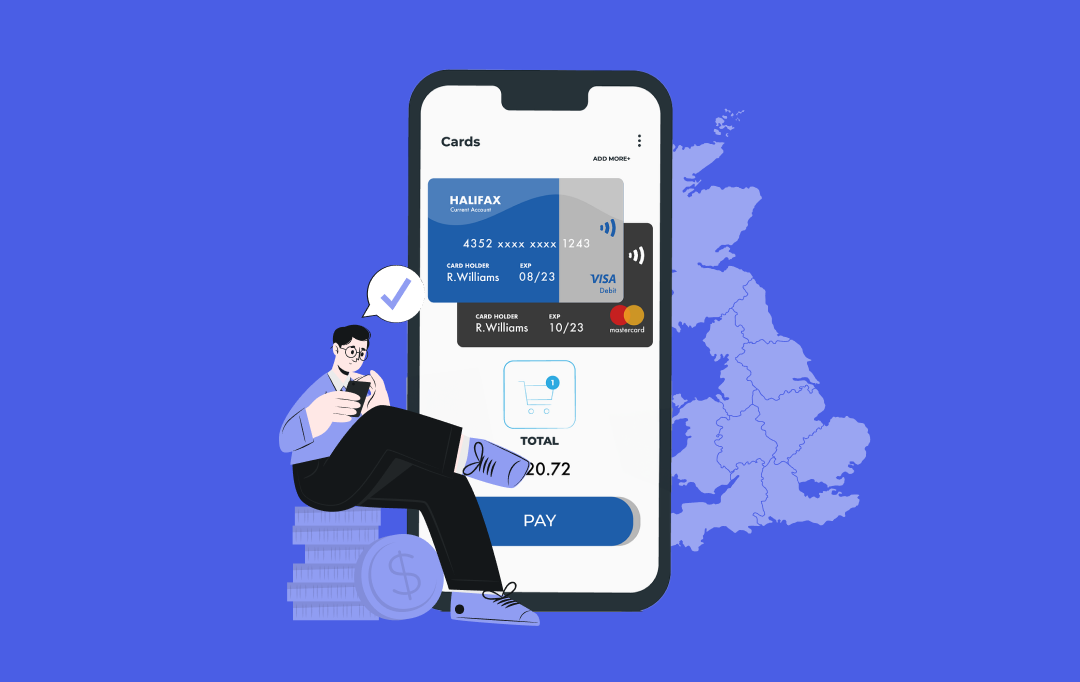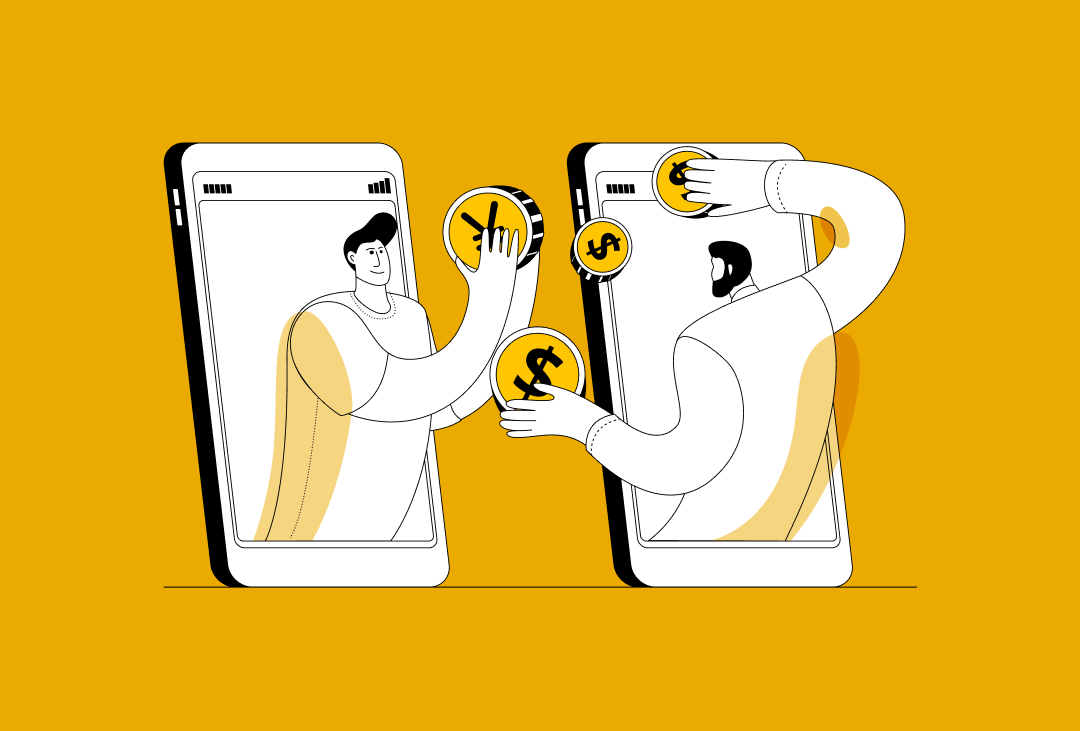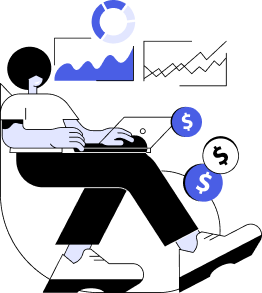- What is the Role of a Personal Finance App for Users?
- Types of Personal Finance Apps
- 1. Simple Finance Apps
- 2. Complex Finance Apps
- Examples of Top Personal Finance Apps in 2025 and beyond
- How to Build a Personal Finance Application?
- Step 1: Define Your Audience
- Step 2: Set the Purpose of the Application
- Step 3: Gather Requirements
- Step 4: Design the User Interface
- Step 5: Develop and Test
- Step 6: Launch the Application
- Step 7: Maintain and Update the Application
- Top 12 Features to Build a Personal Finance App
- 1. Account Integration
- 2. Security Measures
- 3. AI Algorithms
- 4. AI Chatbots for Useful Advice
- 5. Real-Time Spending and Tracking
- 6. Simplicity
- 7. User Experience
- 8. Constant Customer Support
- 9. Alerts and Notifications
- 10. Gamification
- 11. Points and Rewards
- 12. Financial Advice and Consultation
- Cost to Build a Personal Finance App
- How to Monetize a Personal Finance App?
- In-app purchases
- In-app ads
- Subscription Model
- Affiliate Marketing
- Data Monetization
- Start Your Personal Finance App Development Journey with Appinventiv
- FAQs
Over the last decade, the personal finance app development segment has seen steady growth. This growth has been further accelerated by the lockdowns imposed due to the COVID-19 pandemic, as people have had to rely more on digital solutions for their financial needs. The need to track earnings and spending, and to shop online without having to visit a physical bank, has grown rapidly. As a result, investing to build a personal finance app has become highly lucrative.
A personal finance app is an invaluable tool for managing one’s finances. It provides users with an array of features that enable them to track their expenses and make informed decisions about where to invest their money. Not only does this enable users to save, but it also provides them with the opportunity to generate additional income.
This, in turn, is bringing the global personal finance management market on a growth spurt. Thankfully there are many financial software development companies that help build a personal finance app and join the list of market leaders.
What is the Role of a Personal Finance App for Users?
Finance apps make life easier by helping users manage their finances easily and efficiently. The best personal finance app not only helps users with monitoring, budgeting, accounting and expense tracking but also gives helpful insights into money management. It also gives users various investment options, tax advice, insurance inputs, and above all, a proper security system.
The extensive role of a personal finance app makes them secure a robust place in the list of Top Fintech Trends.
So, if you are also planning to build a FinTech app for your business, our latest blog on How Much Does It Cost To Develop A Fintech App will help you plan the development budget effectively.

Types of Personal Finance Apps
There are many types of personal finance applications helps achieve a specific goal for financial institutions and their users. Typically, we can divide financial apps into two main categories – simple apps with manual data entry processes and complex apps with automated entry processes.
Let’s dig a little deeper!
1. Simple Finance Apps
As the name suggests, these are the simplest types of apps to track income and expenditures. These apps generally work on manual information inputs.
Pros:
- The risk factor is zero since no bank accounts are linked to these apps.
- These apps are cost-effective in terms of building a personal finance app.
Cons:
- The human error rate is high because of the manual data entry process.
- The entire process is time taking.
2. Complex Finance Apps
Complex finance apps are more advanced. They allow users to link their bank accounts and cards, through which data is synchronized automatically.
Pros:
- These apps are generally a lot more all-encompassing. They allow users to perform a series of tasks.
- The efficiency of complex finance apps is high since they save valuable time for the user.
- It provides real-time transaction updates, so the user is constantly conscious of the money management process.
Cons:
- Since complex finance apps deal with confidential and crucial data, it requires investing more in security.
- The personal finance app development cost for building complex apps is typically high.
Related Article: Cost of Cleo Like AI Budgeting App

Examples of Top Personal Finance Apps in 2025 and beyond
Managing your finances can be a daunting task, but with the help of personal finance apps, you can spend less time worrying about money and more time taking action. From budgeting to investing, there are apps to help you make the most of your money. With the right app, you can have confidence in your decisions and easily track your progress. So here is a list of the best finance apps.
- Mvelopes – A personal finance app for monitoring a household and personal budget.
- Mint – A personal money management app
- AWSM bank – A Neobank app for kids intends to help parents track and control transactions remotely
- Wally – A personal finance app for tracking transactions, accounts, and budgets.
- EveryDollar – A tool for tracking budgeting and expenses.
From voice payments to online banking, personal finance app development can help satisfy end users’ needs the way you need.
Also Read: How Much Does it Cost to Build a Tax Preparation App Like TurboTax
How to Build a Personal Finance Application?
Building a personal finance application can be a complex process. However, with the help of a professional app development company and the right steps followed, you can gain ground in your FinTech app development project easily and efficiently. Here are some general steps to help you get started.
Step 1: Define Your Audience
The first step in building a personal finance application is to define your target audience; and comprehend the pain points and problems you want to solve. Once you know the challenges your audience is facing, you can choose the required tech stack and features to develop an effective application.
Step 2: Set the Purpose of the Application
Now, it is time to set the purpose of your application. Determine what financial information you want to track, and what features the application will provide. Consider if it’s just for budgeting or for investment tracking, loan calculators or debt reduction plans, or a combination of several features.
Step 3: Gather Requirements
Once you have defined the purpose of your application, do market research and gather all the requirements for your app. It includes features, user interface design, data management, security, and any other necessary functionalities. You should research APIs to integrate data sources and data visualization libraries for data presentation.
Step 4: Design the User Interface
Designing the user interface (UI) is a critical step to build a personal finance application. The user interface should be simple and easy to navigate. It should provide a good user experience, making it easy for users to access information, track expenses, and manage their finances. The UI should also be responsive, working seamlessly on different devices and platforms.
Step 5: Develop and Test
After finalizing the UI design, the development process begins. Start by building the basic functionalities, including user registration and login, data input, and data management. You should also add features like charts and graphs to help users visualize their financial data. Once the development is complete, conduct thorough testing to ensure the application functions smoothly without any issues.
Step 6: Launch the Application
After completing testing and fixing any issues, it’s time to launch the application. You can start by releasing the application to a small group of beta testers to receive feedback and make improvements before launching it publicly. You can also opt for an MVP (minimal viable product) at this stage. Once you get the satisfactory result from MVP, you can consider scaling up the app by introducing more customer-centric features.
Plan for a marketing strategy to promote the app, such as social media, paid ads, or content marketing, to attract new users and build a user base.
Step 7: Maintain and Update the Application
Maintaining and updating the application is an ongoing process. You should continually monitor user feedback and make necessary changes to improve the user experience. Additionally, stay up-to-date on industry trends and security concerns to ensure your application is always relevant and secure.
Also Read: What is the cost of maintaining an app?
Now that you know the essential steps involved in building a personal finance app, it’s time to discuss some essential features that will make your application a big hit in the market.
[Also Read: How to build a financial literacy and money management app like Zogo]
Top 12 Features to Build a Personal Finance App
Irrespective of what type of personal financial app you choose to develop for your business, you must consider getting one built with some essential features required for the success of the application.
Here are some must-have personal financial management app features to consider in 2023.

1. Account Integration
Make sure your financial management software combines the details of all financial accounts of the consumer such as credit cards, debit cards, loans, mutual funds, etc. Your finance app should be a one-stop solution for everything related to or required for money management.
2. Security Measures

Creating a finance management app is one thing but making a secure one is completely a different story. Thankfully, there are many technologies that can help keep your money less vulnerable and more secure. So, make sure your app integrates all the technologies required to reinforce your application’s security. Some of these technologies are listed below:
Biometric Access
It involves unique characteristics of a person, such as voice or fingerprint patterns. With biometrics, it can be extremely difficult for someone to break into your money management app.
Multi-Factor Authentication
This adds an extra coating of security. Multi-factor authentication process makes it even harder for attackers to gain access to a consumer’s sensitive information.
Real-Time Alerts
It is essential that your personal finance management software is technologically advanced to notify users in real-time. It helps customers build great confidence in the application’s use when they know for a fact that they will receive a notification if anyone is trying to access their account or personal information.
Also Read: 7 Valuable Business Lessons That Fintech Startups Can Teach You
3. AI Algorithms
There are many ways AI is reforming the mobile app industry in terms of user engagement and developer app revenue. Artificial intelligence algorithms help personalize the user experience. Here are some common ways AI can make the personal finance management app development process more effective.
- AI will help incorporate expenditure categorization, which aims to classify the cost spent on a specific category, for example, medical, entertainment, groceries, investment, etc.
- AI also looks into expenditure analytics, which automatically updates and provides data visualization of money spent on each category.
4. AI Chatbots for Useful Advice

AI chatbots access all of a customer’s data and then analyze and provide suggestions based on that data. This can include keeping track of spending habits, providing insights into credit scores, and managing budgets. By utilizing AI-based recommendations, customers can manage their money more efficiently. AI-based customer service chatbots are designed to imitate human interactions and provide customers with the information they need quickly and efficiently.
Related Article: 10 Ways Chatbots are Making Banks Smarter
5. Real-Time Spending and Tracking
Make sure to build a personal finance app that can help consumers track their expenditures. This feature will come in handy since the users will not have to switch between apps to track where they are spending or investing their money. It will be effortlessly done on a single platform, saving their time, energy, and money.
6. Simplicity

Even if a money management app includes sensitive data and crucial details, no one likes going through a complex procedure every time they transact or invest. Considering this likelihood, you should develop a personal finance app with the 3 clicks rule in your mind, that is, 3 simple taps are enough to lead the consumers to wherever they want.
7. User Experience
Many times businesses build apps without focusing on the importance of UI/UX design. This ultimately leads to the app’s downfall.
To make your app a big hit in the Fintech market, make sure to build a personal finance app with extremely user-friendly features for easy navigation and better customer satisfaction. This will ultimately lead to business growth.
To create a personal finance app with an intriguing user experience, you must know about your target audience and think as a user. The UI/UX design of your app will be a deciding factor in whether the consumers will accept your application or not.
8. Constant Customer Support
24*7 customer support is of great importance. Customer support in different languages, throughout the day and night, is an ultimate feature that will get you a global clientele and keep your customers loyal.
9. Alerts and Notifications

Notification is one of the most significant features you must add to your finance app development ideas. Sending reminders or notifications occasionally is truly an incredible way to alert customers about their financial reports and make them feel you care about them. Notifications can help consumers in case of
- More expenditure
- Low balance in the account
- Upcoming bills to be paid
- Great deals for investment or savings
10. Gamification
By adding gamification, you can keep your users engaged. This feature will motivate users to interact with the app more frequently. A gamified money app is a practical and fun application that helps them achieve their saving goals better.
11. Points and Rewards
Rewards like discounts, coupons, cashback, credits, etc. are a great way to keep app users engaged and loyal to your application. By gaining such lucrative rewards, users are more likely to remain active and engaged with the app. This can help to attract more users and ensure that the app remains popular.
12. Financial Advice and Consultation
With the help of this innovative feature, users can request financial suggestions or advice from experts in this field. Some Expense Management Software would help them learn more about ways they can save money and keep track of their expenses. They could also learn about various investment options and learn to maintain a good credit score.
[Also Read: How Wealth Tech is Transforming Traditional Finance – 10 Benefits and Use Cases]
Cost to Build a Personal Finance App
The cost of building a personal finance app can vary widely depending on various factors, such as the complexity of the app, the features included, the platforms it is built for, the development team’s location and experience, and many other factors.
However, as a rough estimate, the cost to build a basic personal finance app can range from $35,000 to $80,000. This would include basic features such as budget tracking, expense management, and goal setting.
If you want to include more advanced features such as investment tracking, bill payment, financial planning, and integration with third-party financial services, the cost could go higher and range from $80,000 to $200,000.
It’s essential to keep in mind that building an app is not a one-time cost; ongoing maintenance, updates, and bug fixing will also add to the cost over time.
How to Monetize a Personal Finance App?
Finally, with all hard work, effort, and money, you have developed a personal finance app for your users. Now, you might ask how you will make money through the app. Well, you can monetize your personal finance app development in several ways. Let’s look at some of the most lucrative ways you can use to generate income from your financial app.
In-app purchases
One way to monetize a personal finance app is by offering additional features or tools as in-app purchases. You can allow users to utilize the basic personal finance app features for free, and you can keep the premium features in the paid version. Premium features can include the advanced version of the basic ones, and of course, some new functionalities will always be appreciated by the consumers.
In-app ads
You can also monetize your personal finance app by displaying targeted ads to users. However, be cautious about displaying too many ads as this could negatively impact user experience.
Subscription Model
Another monetization option is to offer a subscription model where users pay a monthly or annual fee to access premium features or tools within the app. This model can work well if your app offers ongoing financial advice or personalized investment recommendations.
Affiliate Marketing
Partnering with financial companies and offering affiliate marketing opportunities is also an exciting way to monetize a personal finance app. For example, through your app, you could partner with a credit card company and earn a commission on users who sign up for a new credit card.
Data Monetization
Finally, you could consider monetizing user data. However, you must be transparent about your data collection and ensure that user privacy is protected. Some potential data monetization strategies include selling aggregated user data to financial institutions or using user data to create personalized financial products.
Ultimately, the best way to monetize a personal finance app will depend on your app’s unique features, target audience, and overall business goals.
Related Article: How Much Money Can You Earn Through An App?
Start Your Personal Finance App Development Journey with Appinventiv
Now that you know the must-have features for a personal finance app, it is time to move to the next step: personal finance app development. Building a personal finance app can be a difficult task due to the competitive nature of the market and the security and compliance risks that come with it. For instance, adhering to complex regulations like GDPR, PCI-DSS, etc. is crucial yet intimidating.
However, with the help of a reliable and experienced personal finance app development company (like Appinventiv), the process can be much easier and smoother. We are an award-winning software and mobile app development company offering reliable fintech application development services to bring your personal finance app ideas to life. We can help you build a personal finance app comprising all the advanced features and an amazing user experience for money management.
FAQs
Q. How to build a personal finance app?
A. Creating a personal finance app is not so easy. It involves a multi-step process to integrate multiple features and design. Also, the obligations like compliance and security risks make the process a real challenge.
However, partnering with an experienced personal finance app development company like Appinventiv can make the process much smoother. Get in touch today, and let’s talk.
Q. What is the cost of developing a personal financial app?
A. The cost of building a basic financial app with viable features such as account management, digital payments, alerts, simple UI/UX design etc. can vary significantly. Typically, the average personal finance app development cost ranges from $30,000 to $55,000.
Q. How much time does it take to build a personal finance app?
A. The time to build a personal finance app can vary depending on several factors, such as the features included, the complexity of the app, the platforms it is built for, the location of the development company, and efficiency at completing the project, and many other factors.
On average, developing a personal finance app like Mint or YNAB will take around 2,000-2,500 hours of constant work.



How Much Does it Cost to Build a Personal Finance App like Pocketsmith?
Imagine an app that knows when your rent is due, reminds you of upcoming bills, forecasts your savings 12 months ahead, and tells you if that third coffee this week is wrecking your budget. That’s the kind of experience apps like PocketSmith deliver, and it’s exactly why personal finance apps are becoming a must-have for…

How Much Does it Cost to Build a Mobile Banking App Like Halifax in the UK?
The way people bank has changed dramatically. Gone are the days of waiting in long queues or rushing to a branch before closing hours. Today, mobile banking apps like Halifax have redefined convenience, allowing users to check balances, transfer funds, pay bills, and even apply for loans from their smartphones, anytime and anywhere. This shift…

How to Approach Currency Converter App Development?
Imagine you’re about to travel abroad and need to quickly check how much your local currency is worth in another country, or perhaps you run an international business and constantly deal with multiple currencies. In both cases, a currency converter app is an indispensable tool. With global transactions becoming the norm and forex markets fluctuating…


















